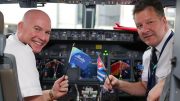The Federal Aviation Administration informed Alaska Airlines and Horizon Air that it has formally accepted each airline’s Safety Management System (SMS), capping a five-year effort to develop and refine a comprehensive, modern SMS for each airline.
A 2015 FAA rule requires all U.S. airlines to create a sophisticated SMS by January 2018. SMS is an evolution in safety and builds on the robust safety programs Alaska and Horizon have had in place for decades. Alaska and Horizon fully implemented their Safety Management Systems in 2012, while the FAA was still validating them.
“Alaska and Horizon employees should feel proud to know that their airlines are leading the industry with their safety programs,” said Ben Minicucci, president and COO of Alaska Airlines. “Our systematic approach involved engineering safety into our culture and every part of our business. Not only are our combined 15,600 employees trained on safety standards, they are empowered to stop the operation if they have a safety concern.”
A Safety Management System integrates and embeds safety throughout the culture and business processes of an airline. Rather than rely on a separate “safety manager” or “safety department” to be in charge of keeping the airline safe, an SMS empowers employees at all levels to participate in and improve the process.
Additionally, as part of the program, executives at both airlines pledge that safety is their first commitment, setting the tone for the entire organization.
“Our SMS helped us show how frontline employees are the bedrock of safety improvements,” said David Campbell, Horizon Air president and CEO. “Our employees know that they are empowered to stop the operation any time to correct a safety concern.”
The FAA’s formal acceptance of Alaska and Horizon’s SMS programs is just one of several safety advances the airlines have made this year. In May, Alaska became the first commercial airline in the world to receive FAA certification of a full-stall model in a flight simulator, which helps pilots train to recognize and recover from stalls. The same month, each airline was served with its 15th Diamond Award of Excellence from the FAA in recognition for their dedication to maintenance training. Additionally, earlier this year, a team of Alaska maintenance technicians took first place in the annual Aerospace Maintenance Competition in Dallas.
“SMS will be a big part of our future,” said Tom Nunn, the airlines’ vice president of safety. “It will help us sustain and build on the efforts we’ve made in the last five years and will allow us to continue to improve on them in the future.”
Alaska Airlines, together with its regional partners, flies 32 million customers a year to more than 110 cities with an average of 970 daily flights throughout the United States, Canada, Costa Rica, Mexico and soon Cuba. With Alaska’s global airline partners, customers can earn and redeem miles to more than 800 destinations worldwide. Onboard, customers are invited to make the most of their flight with amenities like power outlets at every seat, streaming entertainment direct to your device, Wi-Fi and an inspired food and beverage selection featured on most flights. Alaska Airlines ranked “Highest in Customer Satisfaction Among Traditional Carriers in North America” in the J.D. Power North American Airline Satisfaction Study for nine consecutive years from 2008 to 2016. Alaska Airlines Mileage Plan also ranked “Highest in Customer Satisfaction with Airline Loyalty Rewards Programs” in the J.D. Power Airline Loyalty/Rewards Program Satisfaction Report for the last three consecutive years. Alaska Airlines is a subsidiary of Alaska Air Group (NYSE: ALK).
Learn more on the airline’s newsroom, blog, alaskaair.com, @AlaskaAir, facebook.com/alaskaairlines and linkedin.com/company/alaska-airlines.








Be the first to comment on "Alaska Airlines’ Safety Management System accepted by the FAA"